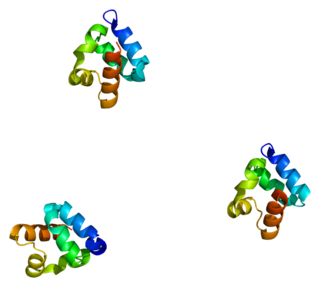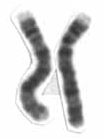
Spectrin is a cytoskeletal protein that lines the intracellular side of the plasma membrane in eukaryotic cells. Spectrin forms pentagonal or hexagonal arrangements, forming a scaffold and playing an important role in maintenance of plasma membrane integrity and cytoskeletal structure. The hexagonal arrangements are formed by tetramers of spectrin subunits associating with short actin filaments at either end of the tetramer. These short actin filaments act as junctional complexes allowing the formation of the hexagonal mesh. The protein is named spectrin since it was first isolated as a major protein component of human red blood cells which had been treated with mild detergents; the detergents lysed the cells and the hemoglobin and other cytoplasmic components were washed out. In the light microscope the basic shape of the red blood cell could still be seen as the spectrin containing submembranous cytoskeleton preserved the shape of the cell in outline. This became known as a red blood cell "ghost" (spectre), and so the major protein of the ghost was named spectrin.

Ankyrins are a family of proteins that mediate the attachment of integral membrane proteins to the spectrin-actin based membrane cytoskeleton. Ankyrins have binding sites for the beta subunit of spectrin and at least 12 families of integral membrane proteins. This linkage is required to maintain the integrity of the plasma membranes and to anchor specific ion channels, ion exchangers and ion transporters in the plasma membrane. The name is derived from the Greek word for "fused".

The ankyrin repeat is a 33-residue motif in proteins consisting of two alpha helices separated by loops, first discovered in signaling proteins in yeast Cdc10 and Drosophila Notch. Domains consisting of ankyrin tandem repeats mediate protein–protein interactions and are among the most common structural motifs in known proteins. They appear in bacterial, archaeal, and eukaryotic proteins, but are far more common in eukaryotes. Ankyrin repeat proteins, though absent in most viruses, are common among poxviruses. Most proteins that contain the motif have four to six repeats, although its namesake ankyrin contains 24, and the largest known number of repeats is 34, predicted in a protein expressed by Giardia lamblia.

SH3 and multiple ankyrin repeat domains protein 1 is a protein that in humans is encoded by the SHANK1 gene.

CARP, also known as Cardiac adriamycin-responsive protein or Cardiac ankyrin repeat protein is a protein that in humans is encoded by the ANKRD1 gene. CARP is highly expressed in cardiac and skeletal muscle, and is a transcription factor involved in development and under conditions of stress. CARP has been implicated in several diseases, including dilated cardiomyopathy, hypertrophic cardiomyopathy, and several skeletal muscle myopathies.

Ankyrin repeat and KH domain-containing protein 1 is a protein that in humans is encoded by the ANKHD1 gene.

SH3 and multiple ankyrin repeat domains 3 (Shank3), also known as proline-rich synapse-associated protein 2 (ProSAP2), is a protein that in humans is encoded by the SHANK3 gene on chromosome 22. Additional isoforms have been described for this gene but they have not yet been experimentally verified.

KN motif and ankyrin repeat domain-containing protein 1 is a protein that in humans is encoded by the KANK1 gene.
{{{Infobox_gene}}} Ankyrin repeat and zinc finger domain-containing protein 1 is a protein that in humans is encoded by the ANKZF1 gene.

Kinase D-interacting substrate of 220 kDa or ARMS is a scaffold protein that in humans is encoded by the KIDINS220 gene.

Ankyrin 1, erythrocytic, also known as ANK1, is a protein that in humans is encoded by the ANK1 gene.

Ankyrin repeat and SOCS box protein 1 is a protein that is in humans, encoded by the ASB1 gene.
Ankyrin-B, also known as Ankyrin-2, is a protein which in humans is encoded by the ANK2 gene. Ankyrin-B is ubiquitously expressed, but shows high expression in cardiac muscle. Ankyrin-B plays an essential role in the localization and membrane stabilization of ion transporters and ion channels in cardiomyocytes, as well as in costamere structures. Mutations in ankyrin-B cause a dominantly-inherited, cardiac arrhythmia syndrome known as ankyrin-B syndrome as well as sick sinus syndrome; mutations have also been associated to a lesser degree with hypertrophic cardiomyopathy. Alterations in ankyrin-B expression levels are observed in human heart failure.

Ankyrin-3 (ANK-3), also known as ankyrin-G, is a protein from ankyrin family that in humans is encoded by the ANK3 gene.
DARPins are genetically engineered antibody mimetic proteins typically exhibiting highly specific and high-affinity target protein binding. They are derived from natural ankyrin proteins, one of the most common classes of binding proteins in nature, which are responsible for diverse functions such as cell signaling, regulation and structural integrity of the cell. DARPins consist of at least three, repeat motifs proteins, and usually consist of four or five. Their molecular mass is about 14 or 18 kDa (kilodaltons) for four- or five-repeat DARPins, respectively.
Ankyrin repeat and sterile alpha motif domain containing 4B is a protein that in humans is encoded by the ANKS4B gene. The gene is also known as HARP. Ankyrin repeats mediate protein-protein interactions in very diverse families of proteins.

POTE ankyrin domain family, member B is a protein in humans that is encoded by the POTEB gene.(Prostate, Ovary, Testes Expressed ankyrin domain family member B).It is most likely involved in mediating protein-protein interaction via its 5 ankyrin domains. POTEB is most probably aids in intracellular signaling, but is not likely to be a secreted or nuclear protein. POTEB's function is likely to be regulated via 17 potential phosphorylation sites. There is currently no evidence to suggest that POTEB has nuclear localization signals.

Ankyrin repeat domain-containing protein 24 is a protein in humans that is coded for by the ANKRD24 gene. The gene is also known as KIAA1981. The protein's function in humans is currently unknown. ANKRD24 is in the protein family that contains ankyrin-repeat domains.
Ankycorbin is an ankyrin repeat and coiled-coil domain containing protein that in humans is encoded by the RAI14 gene. It is expressed in a variety of human tissues and is thought to play a role in actin regulation of ectoplasmic specialization, establishment of sperm polarity and sperm adhesion. It may also promote the integrity of Sertoli cell tight junctions at the blood testis barrier.

B cell scaffold protein with ankyrin repeats 1 is a protein that in humans is encoded by the BANK1 gene.














